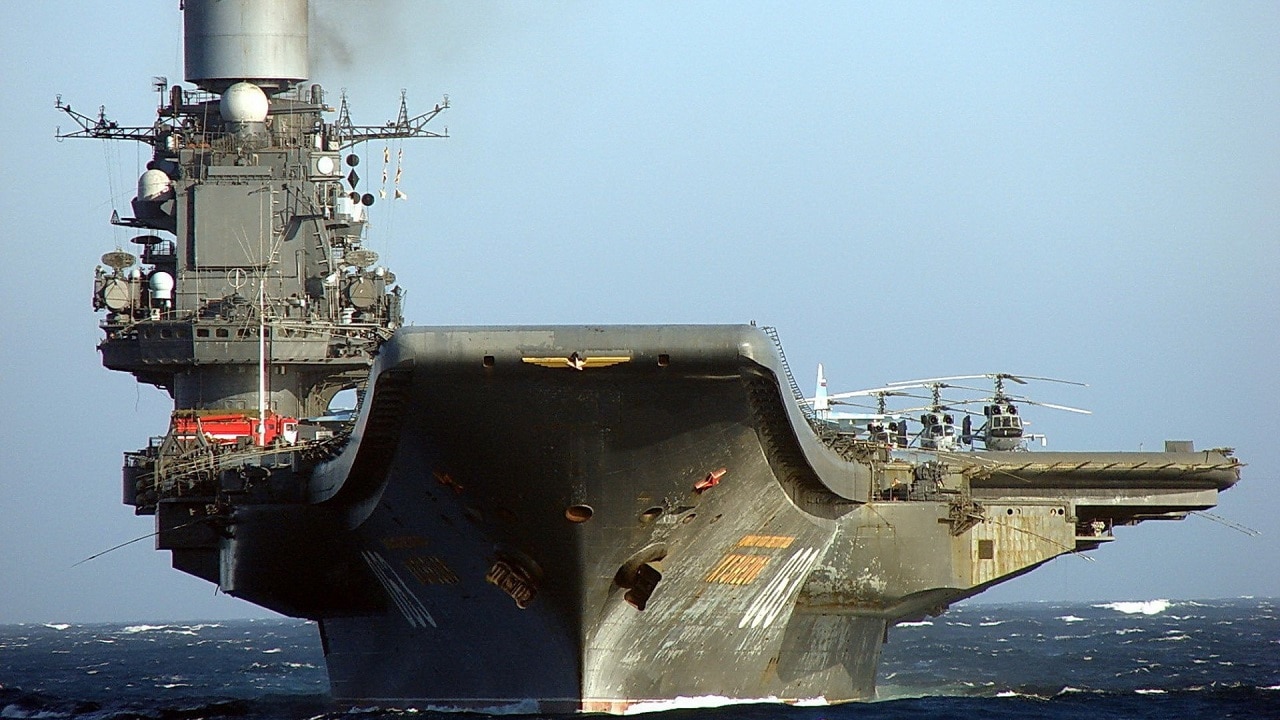The Russian Navy’s flagship aircraft carrier The Admiral of the Soviet Fleet Kuznetsov was once seen with significant pride within the Kremlin, even if it earned mockery elsewhere.
Though it lacked the capabilities and endurance of the United States Navy’s nuclear-powered supercarriers, it allowed the Russian Federation to “show the flag” around the world, and conduct sea-based aerial sorties in remote regions.
It arguably accomplished the goals of the Soviet Navy and was part of the enduring legacy of the Russian Navy that began with Tsar Peter the Great centuries ago.
Major Milestone for Admiral Kuznetsov
The carrier did have a few notable moments.
Its January 2017 deployment to the Mediterranean marked a significant milestone for the Russian Navy – and was reportedly conducted under Russian President Vladimir Putin’s direct orders. During its deployment off the Syrian coast, Admiral Kuznetsov carried out 420 combat missions, during which time it hit 1,252 hostile targets.
That it bellowed black smoke, from the mazut fuel it burned, that could be seen over the horizon, and that it wasn’t all that reliable, was just overlooked by Moscow. It was in a small and exclusive club of nations that had an aircraft carrier.
Even if Putin saw the carrier through rose-colored glasses, foreign navies did not. They saw a significant threat, and not because of its capabilities. In a prior deployment to the Mediterranean, the U.S. Navy had even worried the Russian carrier might flounder or sink; while on more than one occasion, the warship had to be towed back to port.
Ship of Shame!
That latter fact could also explain why the Admiral Kuznetsov was escorted back through the English Channel in February 2017 by a Royal Navy warship and Royal Air Force fighters. It gained international notoriety when then-Defence Secretary Michael Fallon dubbed it the “ship of shame” as it passed through waters close to the English coast belching black smoke.
Admiral Kuznetsov was likely seen more as an environmental and navigational menace than a military threat!
Fortunately for Whitehall, it hasn’t had to worry about the carrier since that time, and it could be years until it will have to monitor the ship’s movements again.
Lengthy Refit
Following that deployment in early 2017, Admiral Kuznetsov began what was expected to be an overhaul and modernization that was to extend the flattop’s service life by 20 to 25 years. It was to be completed by 2021.
But almost immediately the problems began. Little progress was made throughout 2017 and 2018, due to inadequate facilities to actually handle a refit for such a large ship as it had been built at the Nikolayev South Shipyard in what is today Ukraine,
Almost as soon as the refit finally began, in October 2018, a power outage at the floating drydock’s pumps resulted in a catastrophic accident where a 70-ton crane fell on the warship’s flight deck. One worker was killed, and the carrier suffered significant damage.
Even worse was the fact that the 330-meter-long PD-50 drydock sank – seriously impacting the overhaul’s completion date. Just weeks later, a fire broke out on the ship, killing two and injuring 14 others. That required Admiral Kuznetsov to be towed to Severomorsk’s 35th Repair Shipyard, a subsidiary of the Severodvinsk-based “Zwiezdochka” Repair Center.
Cut the Losses?
At that point, Moscow should have opted to retire the problem-plagued vessel, which has essentially become a huge hole in the water. The repair efforts have continued, and at the very earliest the warship could enter service with the Russian Navy in late 2024, yet, officials within the Russian shipbuilding industry have already warned that the date could slip.
“If [the vessel] is tested flawlessly, it may be transferred to the Navy in late 2024. If something goes wrong during the trials, the process will inevitably be postponed to 2025,” an unnamed official told state media outlet Tass in July.
How Long Could It Serve?
What is also noteworthy is that past reporting has suggested that the carrier could serve another 25 years following the refit, but Russian media has reduced that to 20 years. Though the carrier has reportedly been significantly upgraded, which has included new automated systems, it isn’t a ship that had “good bones” to begin with, and it is now older than many of the crew that will likely serve on it.
And that’s only if Russia can actually train a new crew for the ship.
It has been out of service so long that there simply aren’t the officers, midshipmen, sailors, motorists, navigators, and other specialists in the operation and maintenance of aviation equipment, ready to be assigned to the vessel.
When (and perhaps IF) the warship does return to service, Admiral Kuznetsov will be an old, and only moderately upgraded carrier that took years to refit and modernize with systems that are quickly aging, while it will be run by an inexperienced crew.
What could possibly go right?
Author Experience and Expertise
A Senior Editor for 19FortyFive, Peter Suciu is a Michigan-based writer. He has contributed to more than four dozen magazines, newspapers, and websites with over 3,200 published pieces over a twenty-year career in journalism. He regularly writes about military hardware, firearms history, cybersecurity, politics, and international affairs. Peter is also a Contributing Writer for Forbes and Clearance Jobs. You can follow him on Twitter: @PeterSuciu.

